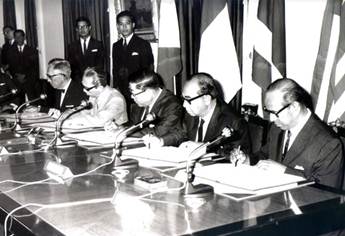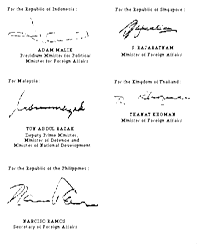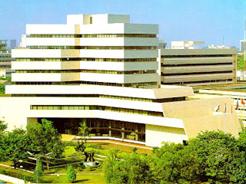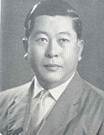Module 1: The Three Pillars of ASEAN
Table of Contents
Reading Text & Presentation
1.1 Founding of the ASEAN community
On 8 August 1967, the Association of Southeast Asian Nations (ASEAN) was established by the five foreign ministers called the Founding Fathers — Adam Malik of Indonesia, Narciso R. Ramos of the Philippines, Tun Abdul Razak of Malaysia, S. Rajaratnam of Singapore, and Thanat Khoman of Thailand — in the main hall of the Department of Foreign Affairs building in Bangkok, Thailand. Then, Brunei joined on 7 January 1984, Vietnam on 28 July 1995, Laos and Myanmar on 23 July 1997, and Cambodia on 30 April 1999, making up what is today the ten member states of ASEAN.
|
|
|
|
|
The Founding Fathers
Source
The ministers signed a document known as the ASEAN Declaration or Bangkok Declaration, which declared the establishment of an Association for Regional Cooperation among the member states of Southeast Asia. Its five articles stated the aims and purposes mainly in terms of cooperation in the economic, social, cultural, technical, educational and other fields, and in the promotion of regional peace and stability through abiding respect for justice and the rule of law, and adherence to the principles of the United Nations Charter.


Signing the Bangkok Declaration
Source
1.1.1 ASEAN Charter
The ASEAN Charter, declared on 15 December 2008 at the ASEAN Secretariat in Jakarta, Indonesia, has become a legally binding agreement among the ASEAN member countries. It serves as firm foundation in achieving the ASEAN Community by providing legal status and institutional frameworks. It also codifies ASEAN norms, rules and values, and presents accountability and compliance. With the entry into force of the ASEAN Charter, ASEAN operated under a new legal framework and established a number of new organs to boost its community-building process. It is also registered with the Secretariat of the United Nations, pursuant to Article 102, Paragraph 1 of the Charter of the United Nations.
The importance of the ASEAN Charter is in the following contexts:
- new political commitment at the top level
- new and enhanced commitments
- new legal framework, legal personality
- new ASEAN bodies
- two new openly-recruited Deputy of Secretary-Generals (DSGs)
- more ASEAN meetings
- more roles for ASEAN Foreign Ministers
- new and enhanced roles for the Secretariat
1.1.2 ASEAN Secretariat
In February 1976, the foreign ministers of ASEAN set up the ASEAN Secretariat. It was housed at the Department of Foreign Affairs of Indonesia in Jakarta. The existing ASEAN Secretariat at 70A Jalan Sisingamangaraja, Jakarta, was established and officiated in 1981 by the then President of Indonesia, H.E. Soeharto. The ASEAN Secretariat's basic function is to provide for greater efficiency in the coordination of ASEAN organs and for more effective implementation of ASEAN projects and activities. The ASEAN Secretariat's vision is that by 2015, it will be the nerve center of a strong and confident ASEAN Community. Its mission is to initiate, facilitate, and coordinate ASEAN stakeholder collaboration according to the ASEAN Charter.

ASEAN Secretariat headquarters in Indonesia
Source
1.1.3 English as the official language in ASEAN
According to the ASEAN Charter, Article 34 states, “The working language of ASEAN shall be English.” After 2015, ASEAN will open a free labor market. All the interactions: reports, records statements and all those concerned with ASEAN will be in the English language. With the growing use of English in business, science, technology and travel, English communication in the ASEAN nations will open the door to greater understanding and appreciation among professionals in different backgrounds. Therefore, practical communication skills in English will foster a sense of professional accomplishment and growth.
Therefore, Singapore, Malaysia, Brunei and Thailand are the main destination countries for migrant workers within the Southeast Asia region because they are more economically developed. Even though, Malaysia and Singapore have a restrict regulation to limit permanent migrant workers, the movement of labor from Indonesia to Malaysian and Singapore, and from the Philippines to Malaysia still continues with workers seeking better income and working conditions. The movement of those highly professional is associated with the inflow of foreign direct investment (FDI), while the movement of semi-skilled and unskilled workers is associated with labor shortage in three importing countries; Singapore, Malaysia and Brunei with workers coming from Indonesia, Thailand, the Philippines, and Thailand.
Language Focus 1.1
Language Focus 1Language Focus 2
Activities




